Management Accounting Report: XLG Business and Variance Analysis
VerifiedAdded on 2023/01/09
|14
|3460
|98
Report
AI Summary
This report delves into the core principles of management accounting, focusing on variance analysis within the context of the XLG business case. It examines sales price variance, sales volume contribution variance, material price planning variance, and material price operational variance, providing detailed calculations and interpretations. The report critically analyzes the merits and demerits of using variances to assess manager performance, discussing the advantages of identifying deviations from planned outcomes, controlling costs, and improving budget projections, alongside the disadvantages of delayed information and potential inaccuracies. Furthermore, the report explores the competitive advantages of FamaQ for XLG, considering the impact of increased demand and production costs. The report also acknowledges the assignment brief's requirement for a report format, which is reflected in the structured presentation of the analysis and findings. The conclusion summarizes the key insights and recommendations derived from the analysis, reinforcing the importance of variance analysis in managerial decision-making.
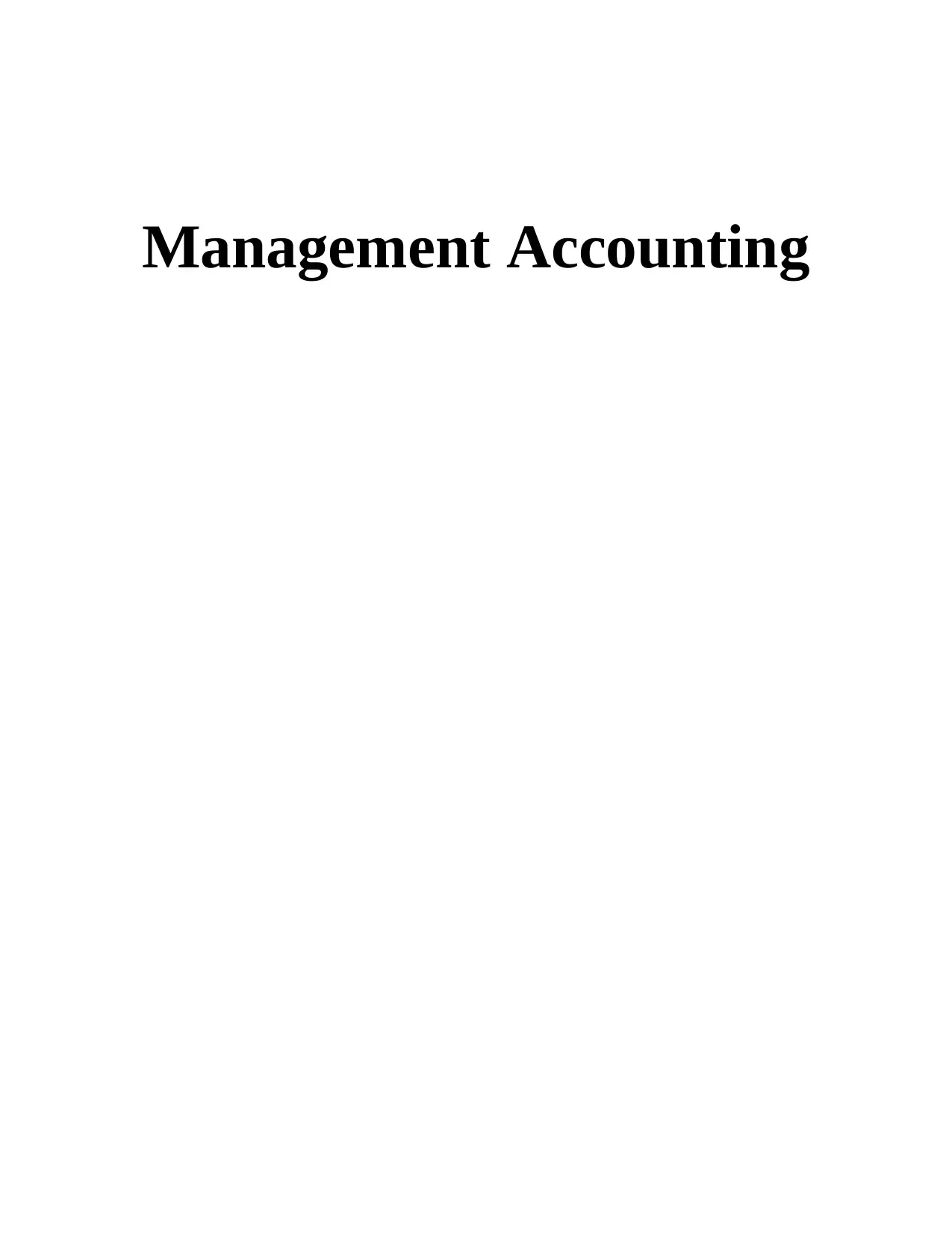
Management Accounting
Paraphrase This Document
Need a fresh take? Get an instant paraphrase of this document with our AI Paraphraser
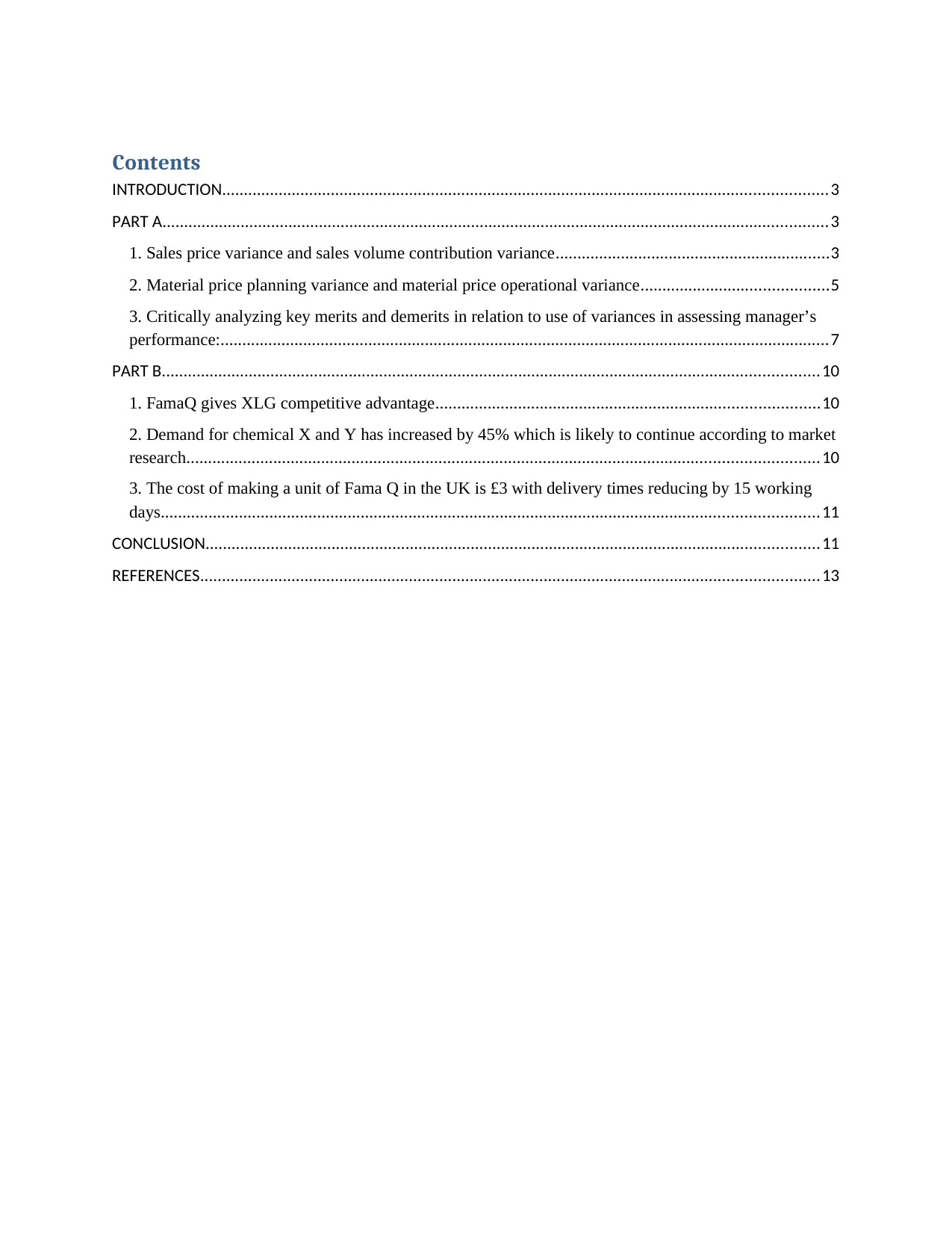
Contents
INTRODUCTION...........................................................................................................................................3
PART A.........................................................................................................................................................3
1. Sales price variance and sales volume contribution variance...............................................................3
2. Material price planning variance and material price operational variance...........................................5
3. Critically analyzing key merits and demerits in relation to use of variances in assessing manager’s
performance:............................................................................................................................................7
PART B.......................................................................................................................................................10
1. FamaQ gives XLG competitive advantage........................................................................................10
2. Demand for chemical X and Y has increased by 45% which is likely to continue according to market
research.................................................................................................................................................10
3. The cost of making a unit of Fama Q in the UK is £3 with delivery times reducing by 15 working
days.......................................................................................................................................................11
CONCLUSION.............................................................................................................................................11
REFERENCES..............................................................................................................................................13
INTRODUCTION...........................................................................................................................................3
PART A.........................................................................................................................................................3
1. Sales price variance and sales volume contribution variance...............................................................3
2. Material price planning variance and material price operational variance...........................................5
3. Critically analyzing key merits and demerits in relation to use of variances in assessing manager’s
performance:............................................................................................................................................7
PART B.......................................................................................................................................................10
1. FamaQ gives XLG competitive advantage........................................................................................10
2. Demand for chemical X and Y has increased by 45% which is likely to continue according to market
research.................................................................................................................................................10
3. The cost of making a unit of Fama Q in the UK is £3 with delivery times reducing by 15 working
days.......................................................................................................................................................11
CONCLUSION.............................................................................................................................................11
REFERENCES..............................................................................................................................................13
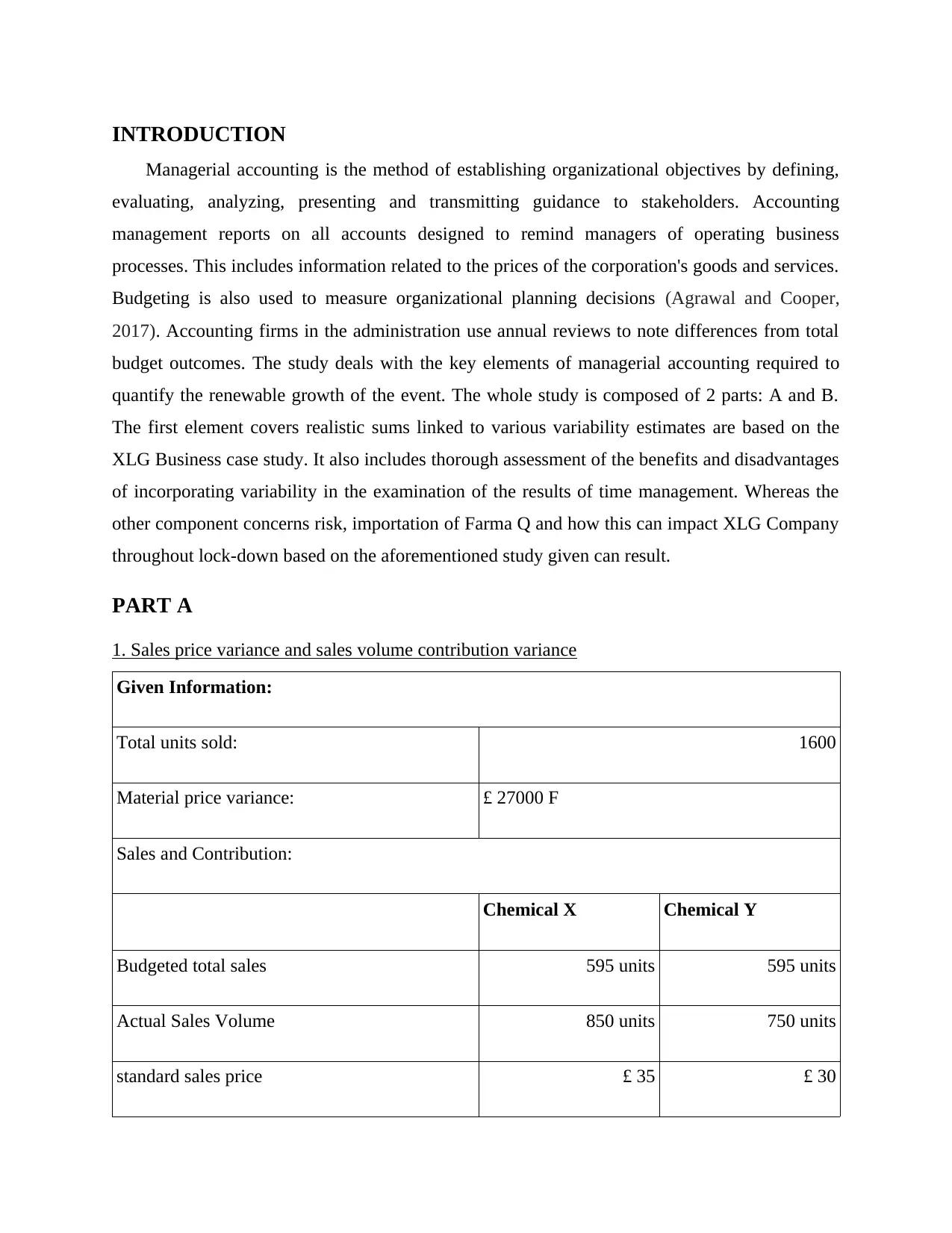
INTRODUCTION
Managerial accounting is the method of establishing organizational objectives by defining,
evaluating, analyzing, presenting and transmitting guidance to stakeholders. Accounting
management reports on all accounts designed to remind managers of operating business
processes. This includes information related to the prices of the corporation's goods and services.
Budgeting is also used to measure organizational planning decisions (Agrawal and Cooper,
2017). Accounting firms in the administration use annual reviews to note differences from total
budget outcomes. The study deals with the key elements of managerial accounting required to
quantify the renewable growth of the event. The whole study is composed of 2 parts: A and B.
The first element covers realistic sums linked to various variability estimates are based on the
XLG Business case study. It also includes thorough assessment of the benefits and disadvantages
of incorporating variability in the examination of the results of time management. Whereas the
other component concerns risk, importation of Farma Q and how this can impact XLG Company
throughout lock-down based on the aforementioned study given can result.
PART A
1. Sales price variance and sales volume contribution variance
Given Information:
Total units sold: 1600
Material price variance: £ 27000 F
Sales and Contribution:
Chemical X Chemical Y
Budgeted total sales 595 units 595 units
Actual Sales Volume 850 units 750 units
standard sales price £ 35 £ 30
Managerial accounting is the method of establishing organizational objectives by defining,
evaluating, analyzing, presenting and transmitting guidance to stakeholders. Accounting
management reports on all accounts designed to remind managers of operating business
processes. This includes information related to the prices of the corporation's goods and services.
Budgeting is also used to measure organizational planning decisions (Agrawal and Cooper,
2017). Accounting firms in the administration use annual reviews to note differences from total
budget outcomes. The study deals with the key elements of managerial accounting required to
quantify the renewable growth of the event. The whole study is composed of 2 parts: A and B.
The first element covers realistic sums linked to various variability estimates are based on the
XLG Business case study. It also includes thorough assessment of the benefits and disadvantages
of incorporating variability in the examination of the results of time management. Whereas the
other component concerns risk, importation of Farma Q and how this can impact XLG Company
throughout lock-down based on the aforementioned study given can result.
PART A
1. Sales price variance and sales volume contribution variance
Given Information:
Total units sold: 1600
Material price variance: £ 27000 F
Sales and Contribution:
Chemical X Chemical Y
Budgeted total sales 595 units 595 units
Actual Sales Volume 850 units 750 units
standard sales price £ 35 £ 30
⊘ This is a preview!⊘
Do you want full access?
Subscribe today to unlock all pages.

Trusted by 1+ million students worldwide
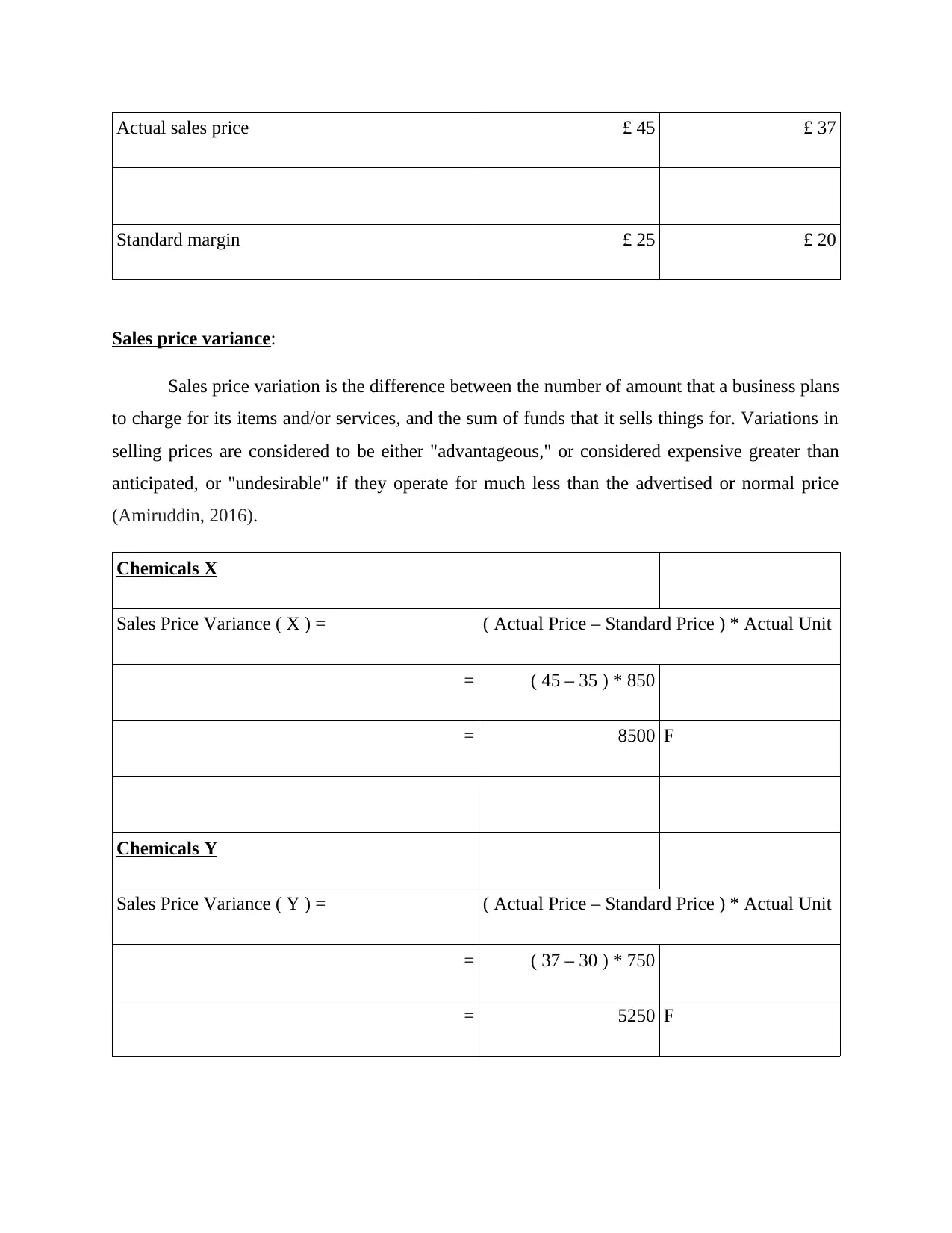
Actual sales price £ 45 £ 37
Standard margin £ 25 £ 20
Sales price variance:
Sales price variation is the difference between the number of amount that a business plans
to charge for its items and/or services, and the sum of funds that it sells things for. Variations in
selling prices are considered to be either "advantageous," or considered expensive greater than
anticipated, or "undesirable" if they operate for much less than the advertised or normal price
(Amiruddin, 2016).
Chemicals X
Sales Price Variance ( X ) = ( Actual Price – Standard Price ) * Actual Unit
= ( 45 – 35 ) * 850
= 8500 F
Chemicals Y
Sales Price Variance ( Y ) = ( Actual Price – Standard Price ) * Actual Unit
= ( 37 – 30 ) * 750
= 5250 F
Standard margin £ 25 £ 20
Sales price variance:
Sales price variation is the difference between the number of amount that a business plans
to charge for its items and/or services, and the sum of funds that it sells things for. Variations in
selling prices are considered to be either "advantageous," or considered expensive greater than
anticipated, or "undesirable" if they operate for much less than the advertised or normal price
(Amiruddin, 2016).
Chemicals X
Sales Price Variance ( X ) = ( Actual Price – Standard Price ) * Actual Unit
= ( 45 – 35 ) * 850
= 8500 F
Chemicals Y
Sales Price Variance ( Y ) = ( Actual Price – Standard Price ) * Actual Unit
= ( 37 – 30 ) * 750
= 5250 F
Paraphrase This Document
Need a fresh take? Get an instant paraphrase of this document with our AI Paraphraser
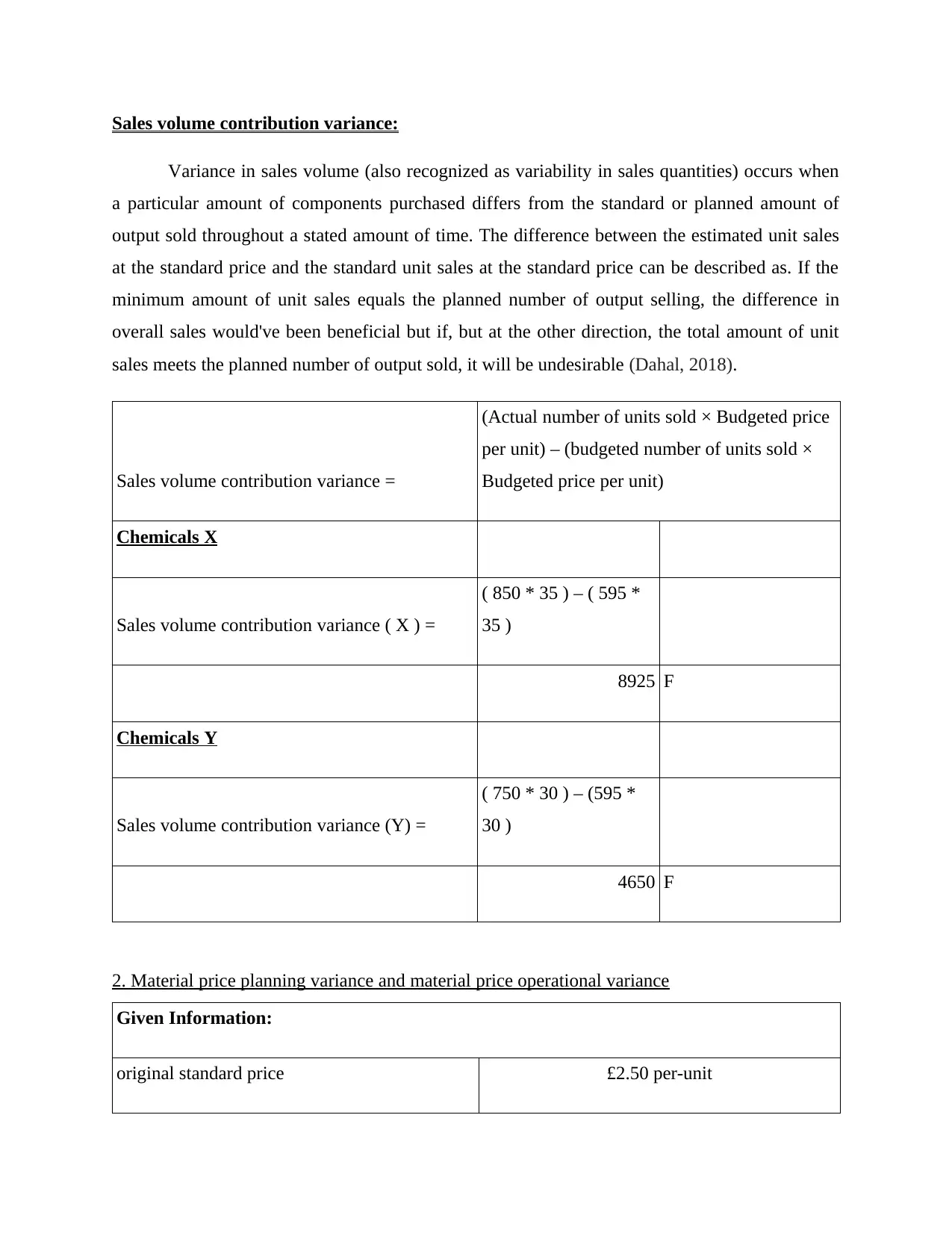
Sales volume contribution variance:
Variance in sales volume (also recognized as variability in sales quantities) occurs when
a particular amount of components purchased differs from the standard or planned amount of
output sold throughout a stated amount of time. The difference between the estimated unit sales
at the standard price and the standard unit sales at the standard price can be described as. If the
minimum amount of unit sales equals the planned number of output selling, the difference in
overall sales would've been beneficial but if, but at the other direction, the total amount of unit
sales meets the planned number of output sold, it will be undesirable (Dahal, 2018).
Sales volume contribution variance =
(Actual number of units sold × Budgeted price
per unit) – (budgeted number of units sold ×
Budgeted price per unit)
Chemicals X
Sales volume contribution variance ( X ) =
( 850 * 35 ) – ( 595 *
35 )
8925 F
Chemicals Y
Sales volume contribution variance (Y) =
( 750 * 30 ) – (595 *
30 )
4650 F
2. Material price planning variance and material price operational variance
Given Information:
original standard price £2.50 per-unit
Variance in sales volume (also recognized as variability in sales quantities) occurs when
a particular amount of components purchased differs from the standard or planned amount of
output sold throughout a stated amount of time. The difference between the estimated unit sales
at the standard price and the standard unit sales at the standard price can be described as. If the
minimum amount of unit sales equals the planned number of output selling, the difference in
overall sales would've been beneficial but if, but at the other direction, the total amount of unit
sales meets the planned number of output sold, it will be undesirable (Dahal, 2018).
Sales volume contribution variance =
(Actual number of units sold × Budgeted price
per unit) – (budgeted number of units sold ×
Budgeted price per unit)
Chemicals X
Sales volume contribution variance ( X ) =
( 850 * 35 ) – ( 595 *
35 )
8925 F
Chemicals Y
Sales volume contribution variance (Y) =
( 750 * 30 ) – (595 *
30 )
4650 F
2. Material price planning variance and material price operational variance
Given Information:
original standard price £2.50 per-unit
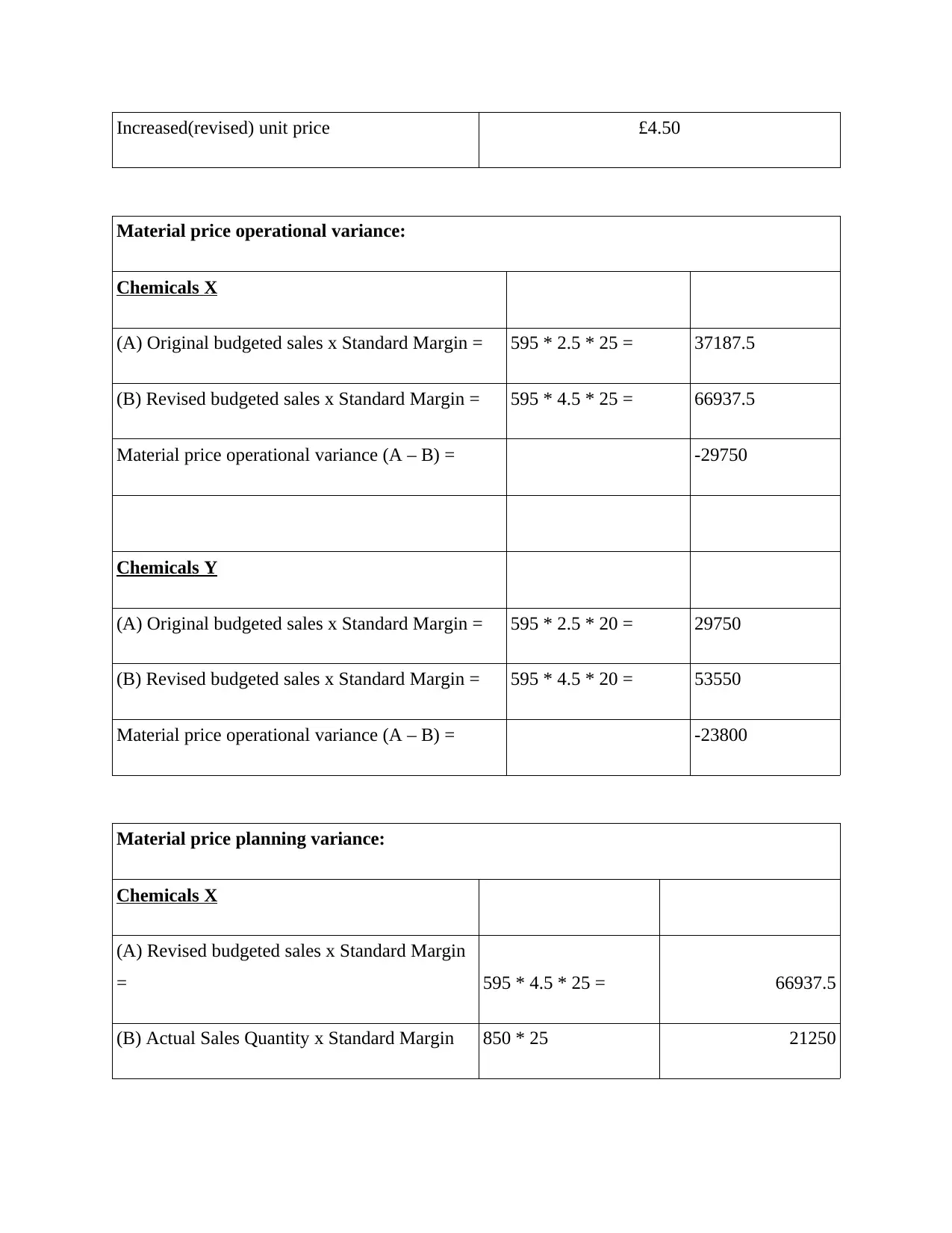
Increased(revised) unit price £4.50
Material price operational variance:
Chemicals X
(A) Original budgeted sales x Standard Margin = 595 * 2.5 * 25 = 37187.5
(B) Revised budgeted sales x Standard Margin = 595 * 4.5 * 25 = 66937.5
Material price operational variance (A – B) = -29750
Chemicals Y
(A) Original budgeted sales x Standard Margin = 595 * 2.5 * 20 = 29750
(B) Revised budgeted sales x Standard Margin = 595 * 4.5 * 20 = 53550
Material price operational variance (A – B) = -23800
Material price planning variance:
Chemicals X
(A) Revised budgeted sales x Standard Margin
= 595 * 4.5 * 25 = 66937.5
(B) Actual Sales Quantity x Standard Margin 850 * 25 21250
Material price operational variance:
Chemicals X
(A) Original budgeted sales x Standard Margin = 595 * 2.5 * 25 = 37187.5
(B) Revised budgeted sales x Standard Margin = 595 * 4.5 * 25 = 66937.5
Material price operational variance (A – B) = -29750
Chemicals Y
(A) Original budgeted sales x Standard Margin = 595 * 2.5 * 20 = 29750
(B) Revised budgeted sales x Standard Margin = 595 * 4.5 * 20 = 53550
Material price operational variance (A – B) = -23800
Material price planning variance:
Chemicals X
(A) Revised budgeted sales x Standard Margin
= 595 * 4.5 * 25 = 66937.5
(B) Actual Sales Quantity x Standard Margin 850 * 25 21250
⊘ This is a preview!⊘
Do you want full access?
Subscribe today to unlock all pages.

Trusted by 1+ million students worldwide
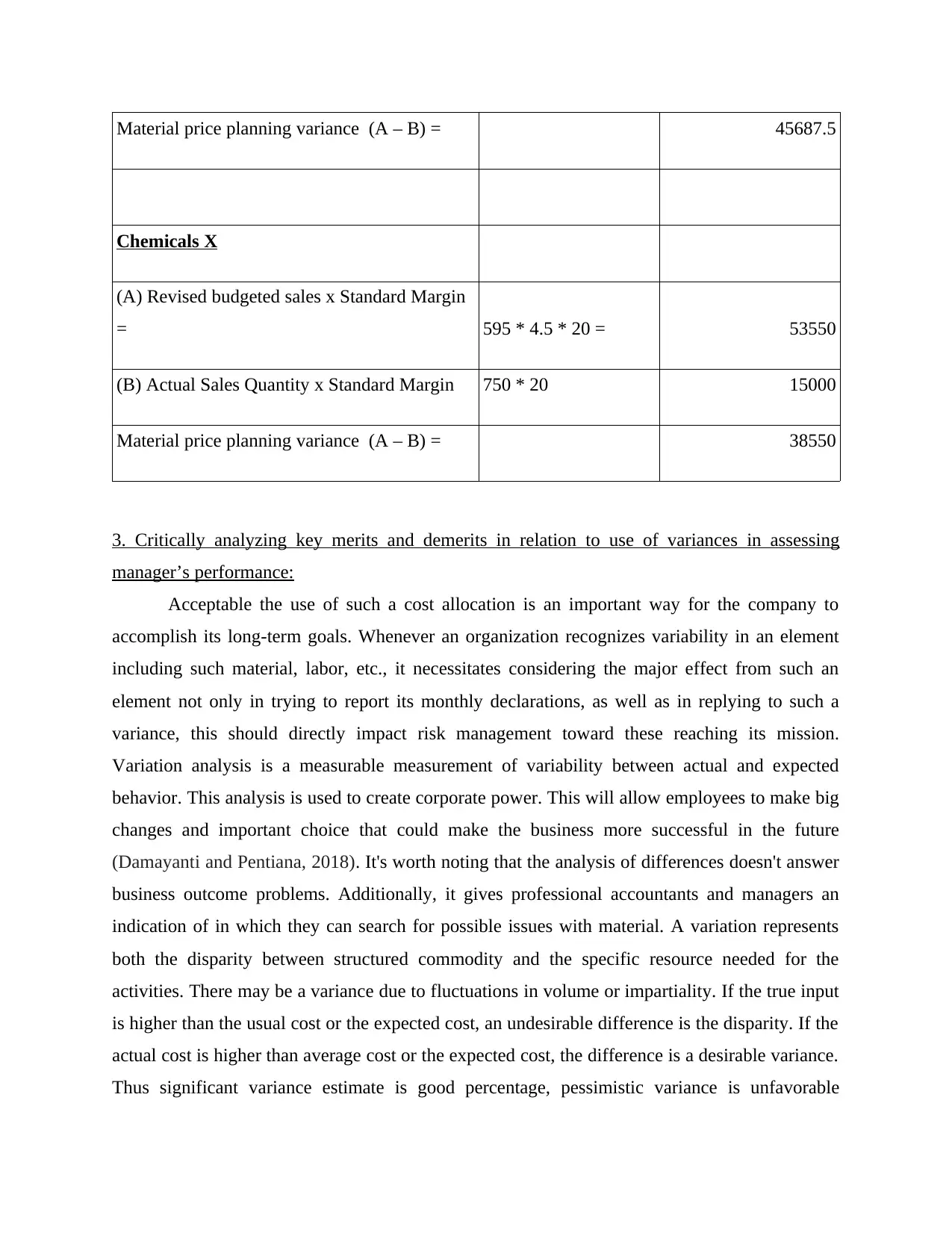
Material price planning variance (A – B) = 45687.5
Chemicals X
(A) Revised budgeted sales x Standard Margin
= 595 * 4.5 * 20 = 53550
(B) Actual Sales Quantity x Standard Margin 750 * 20 15000
Material price planning variance (A – B) = 38550
3. Critically analyzing key merits and demerits in relation to use of variances in assessing
manager’s performance:
Acceptable the use of such a cost allocation is an important way for the company to
accomplish its long-term goals. Whenever an organization recognizes variability in an element
including such material, labor, etc., it necessitates considering the major effect from such an
element not only in trying to report its monthly declarations, as well as in replying to such a
variance, this should directly impact risk management toward these reaching its mission.
Variation analysis is a measurable measurement of variability between actual and expected
behavior. This analysis is used to create corporate power. This will allow employees to make big
changes and important choice that could make the business more successful in the future
(Damayanti and Pentiana, 2018). It's worth noting that the analysis of differences doesn't answer
business outcome problems. Additionally, it gives professional accountants and managers an
indication of in which they can search for possible issues with material. A variation represents
both the disparity between structured commodity and the specific resource needed for the
activities. There may be a variance due to fluctuations in volume or impartiality. If the true input
is higher than the usual cost or the expected cost, an undesirable difference is the disparity. If the
actual cost is higher than average cost or the expected cost, the difference is a desirable variance.
Thus significant variance estimate is good percentage, pessimistic variance is unfavorable
Chemicals X
(A) Revised budgeted sales x Standard Margin
= 595 * 4.5 * 20 = 53550
(B) Actual Sales Quantity x Standard Margin 750 * 20 15000
Material price planning variance (A – B) = 38550
3. Critically analyzing key merits and demerits in relation to use of variances in assessing
manager’s performance:
Acceptable the use of such a cost allocation is an important way for the company to
accomplish its long-term goals. Whenever an organization recognizes variability in an element
including such material, labor, etc., it necessitates considering the major effect from such an
element not only in trying to report its monthly declarations, as well as in replying to such a
variance, this should directly impact risk management toward these reaching its mission.
Variation analysis is a measurable measurement of variability between actual and expected
behavior. This analysis is used to create corporate power. This will allow employees to make big
changes and important choice that could make the business more successful in the future
(Damayanti and Pentiana, 2018). It's worth noting that the analysis of differences doesn't answer
business outcome problems. Additionally, it gives professional accountants and managers an
indication of in which they can search for possible issues with material. A variation represents
both the disparity between structured commodity and the specific resource needed for the
activities. There may be a variance due to fluctuations in volume or impartiality. If the true input
is higher than the usual cost or the expected cost, an undesirable difference is the disparity. If the
actual cost is higher than average cost or the expected cost, the difference is a desirable variance.
Thus significant variance estimate is good percentage, pessimistic variance is unfavorable
Paraphrase This Document
Need a fresh take? Get an instant paraphrase of this document with our AI Paraphraser
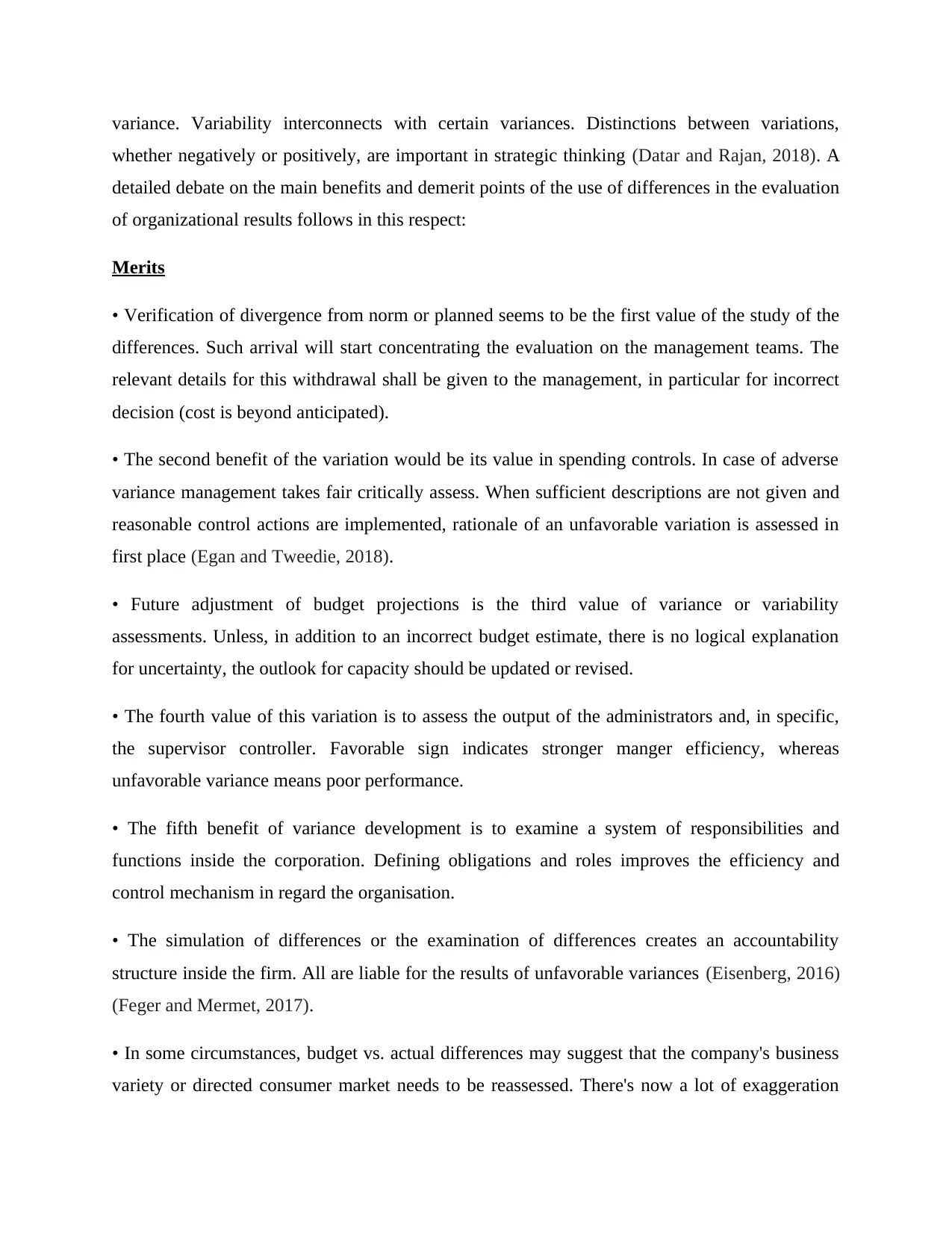
variance. Variability interconnects with certain variances. Distinctions between variations,
whether negatively or positively, are important in strategic thinking (Datar and Rajan, 2018). A
detailed debate on the main benefits and demerit points of the use of differences in the evaluation
of organizational results follows in this respect:
Merits
• Verification of divergence from norm or planned seems to be the first value of the study of the
differences. Such arrival will start concentrating the evaluation on the management teams. The
relevant details for this withdrawal shall be given to the management, in particular for incorrect
decision (cost is beyond anticipated).
• The second benefit of the variation would be its value in spending controls. In case of adverse
variance management takes fair critically assess. When sufficient descriptions are not given and
reasonable control actions are implemented, rationale of an unfavorable variation is assessed in
first place (Egan and Tweedie, 2018).
• Future adjustment of budget projections is the third value of variance or variability
assessments. Unless, in addition to an incorrect budget estimate, there is no logical explanation
for uncertainty, the outlook for capacity should be updated or revised.
• The fourth value of this variation is to assess the output of the administrators and, in specific,
the supervisor controller. Favorable sign indicates stronger manger efficiency, whereas
unfavorable variance means poor performance.
• The fifth benefit of variance development is to examine a system of responsibilities and
functions inside the corporation. Defining obligations and roles improves the efficiency and
control mechanism in regard the organisation.
• The simulation of differences or the examination of differences creates an accountability
structure inside the firm. All are liable for the results of unfavorable variances (Eisenberg, 2016)
(Feger and Mermet, 2017).
• In some circumstances, budget vs. actual differences may suggest that the company's business
variety or directed consumer market needs to be reassessed. There's now a lot of exaggeration
whether negatively or positively, are important in strategic thinking (Datar and Rajan, 2018). A
detailed debate on the main benefits and demerit points of the use of differences in the evaluation
of organizational results follows in this respect:
Merits
• Verification of divergence from norm or planned seems to be the first value of the study of the
differences. Such arrival will start concentrating the evaluation on the management teams. The
relevant details for this withdrawal shall be given to the management, in particular for incorrect
decision (cost is beyond anticipated).
• The second benefit of the variation would be its value in spending controls. In case of adverse
variance management takes fair critically assess. When sufficient descriptions are not given and
reasonable control actions are implemented, rationale of an unfavorable variation is assessed in
first place (Egan and Tweedie, 2018).
• Future adjustment of budget projections is the third value of variance or variability
assessments. Unless, in addition to an incorrect budget estimate, there is no logical explanation
for uncertainty, the outlook for capacity should be updated or revised.
• The fourth value of this variation is to assess the output of the administrators and, in specific,
the supervisor controller. Favorable sign indicates stronger manger efficiency, whereas
unfavorable variance means poor performance.
• The fifth benefit of variance development is to examine a system of responsibilities and
functions inside the corporation. Defining obligations and roles improves the efficiency and
control mechanism in regard the organisation.
• The simulation of differences or the examination of differences creates an accountability
structure inside the firm. All are liable for the results of unfavorable variances (Eisenberg, 2016)
(Feger and Mermet, 2017).
• In some circumstances, budget vs. actual differences may suggest that the company's business
variety or directed consumer market needs to be reassessed. There's now a lot of exaggeration
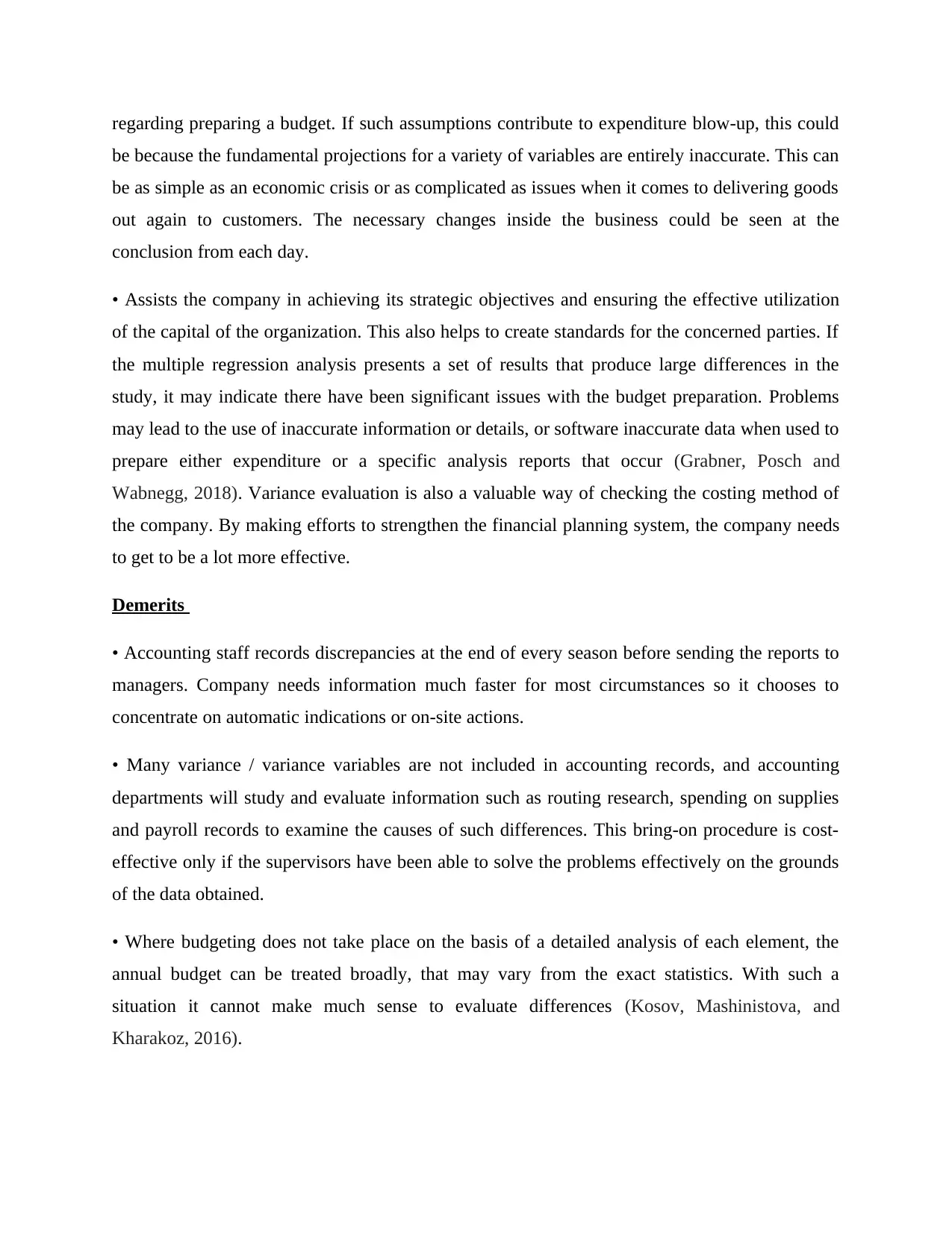
regarding preparing a budget. If such assumptions contribute to expenditure blow-up, this could
be because the fundamental projections for a variety of variables are entirely inaccurate. This can
be as simple as an economic crisis or as complicated as issues when it comes to delivering goods
out again to customers. The necessary changes inside the business could be seen at the
conclusion from each day.
• Assists the company in achieving its strategic objectives and ensuring the effective utilization
of the capital of the organization. This also helps to create standards for the concerned parties. If
the multiple regression analysis presents a set of results that produce large differences in the
study, it may indicate there have been significant issues with the budget preparation. Problems
may lead to the use of inaccurate information or details, or software inaccurate data when used to
prepare either expenditure or a specific analysis reports that occur (Grabner, Posch and
Wabnegg, 2018). Variance evaluation is also a valuable way of checking the costing method of
the company. By making efforts to strengthen the financial planning system, the company needs
to get to be a lot more effective.
Demerits
• Accounting staff records discrepancies at the end of every season before sending the reports to
managers. Company needs information much faster for most circumstances so it chooses to
concentrate on automatic indications or on-site actions.
• Many variance / variance variables are not included in accounting records, and accounting
departments will study and evaluate information such as routing research, spending on supplies
and payroll records to examine the causes of such differences. This bring-on procedure is cost-
effective only if the supervisors have been able to solve the problems effectively on the grounds
of the data obtained.
• Where budgeting does not take place on the basis of a detailed analysis of each element, the
annual budget can be treated broadly, that may vary from the exact statistics. With such a
situation it cannot make much sense to evaluate differences (Kosov, Mashinistova, and
Kharakoz, 2016).
be because the fundamental projections for a variety of variables are entirely inaccurate. This can
be as simple as an economic crisis or as complicated as issues when it comes to delivering goods
out again to customers. The necessary changes inside the business could be seen at the
conclusion from each day.
• Assists the company in achieving its strategic objectives and ensuring the effective utilization
of the capital of the organization. This also helps to create standards for the concerned parties. If
the multiple regression analysis presents a set of results that produce large differences in the
study, it may indicate there have been significant issues with the budget preparation. Problems
may lead to the use of inaccurate information or details, or software inaccurate data when used to
prepare either expenditure or a specific analysis reports that occur (Grabner, Posch and
Wabnegg, 2018). Variance evaluation is also a valuable way of checking the costing method of
the company. By making efforts to strengthen the financial planning system, the company needs
to get to be a lot more effective.
Demerits
• Accounting staff records discrepancies at the end of every season before sending the reports to
managers. Company needs information much faster for most circumstances so it chooses to
concentrate on automatic indications or on-site actions.
• Many variance / variance variables are not included in accounting records, and accounting
departments will study and evaluate information such as routing research, spending on supplies
and payroll records to examine the causes of such differences. This bring-on procedure is cost-
effective only if the supervisors have been able to solve the problems effectively on the grounds
of the data obtained.
• Where budgeting does not take place on the basis of a detailed analysis of each element, the
annual budget can be treated broadly, that may vary from the exact statistics. With such a
situation it cannot make much sense to evaluate differences (Kosov, Mashinistova, and
Kharakoz, 2016).
⊘ This is a preview!⊘
Do you want full access?
Subscribe today to unlock all pages.

Trusted by 1+ million students worldwide
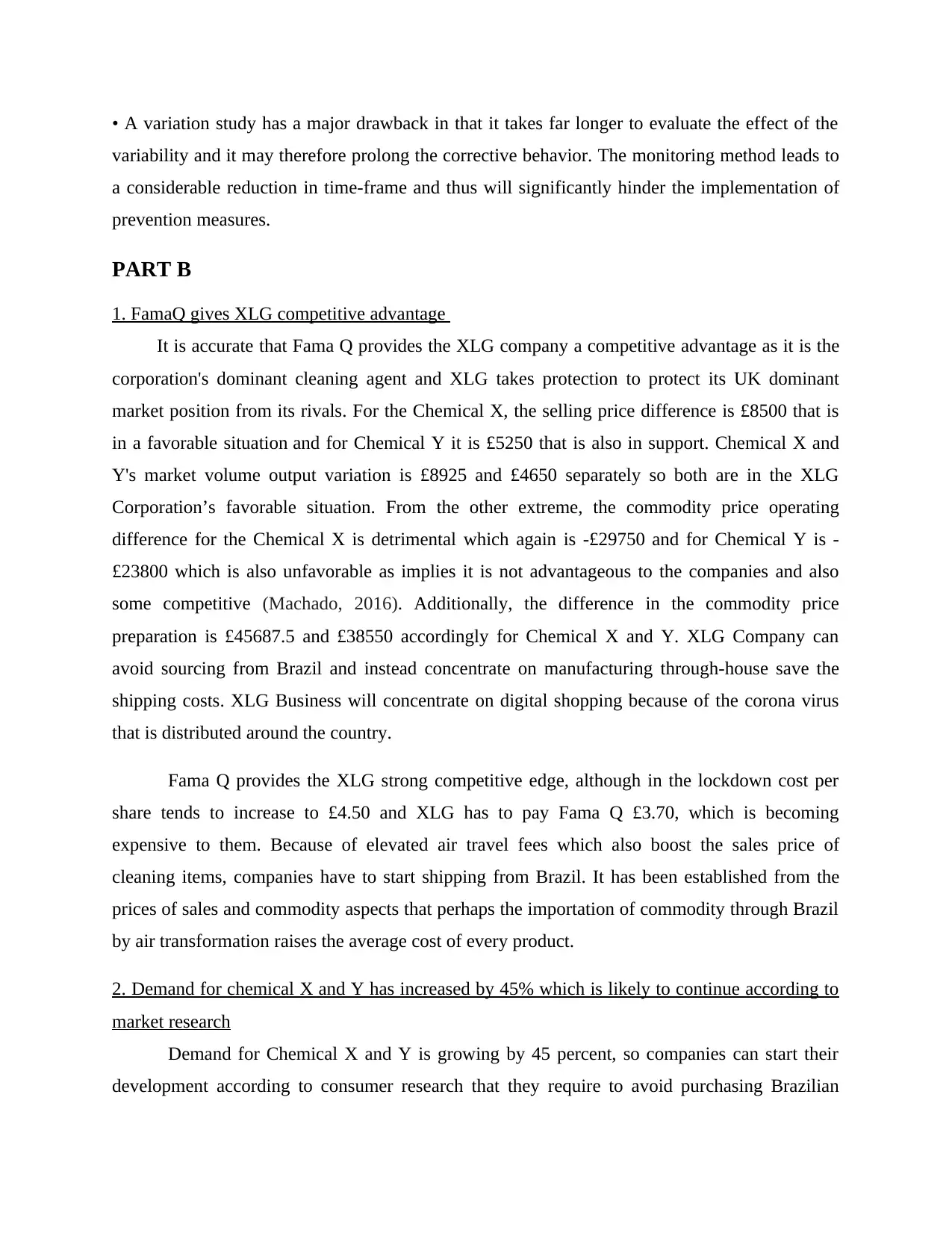
• A variation study has a major drawback in that it takes far longer to evaluate the effect of the
variability and it may therefore prolong the corrective behavior. The monitoring method leads to
a considerable reduction in time-frame and thus will significantly hinder the implementation of
prevention measures.
PART B
1. FamaQ gives XLG competitive advantage
It is accurate that Fama Q provides the XLG company a competitive advantage as it is the
corporation's dominant cleaning agent and XLG takes protection to protect its UK dominant
market position from its rivals. For the Chemical X, the selling price difference is £8500 that is
in a favorable situation and for Chemical Y it is £5250 that is also in support. Chemical X and
Y's market volume output variation is £8925 and £4650 separately so both are in the XLG
Corporation’s favorable situation. From the other extreme, the commodity price operating
difference for the Chemical X is detrimental which again is -£29750 and for Chemical Y is -
£23800 which is also unfavorable as implies it is not advantageous to the companies and also
some competitive (Machado, 2016). Additionally, the difference in the commodity price
preparation is £45687.5 and £38550 accordingly for Chemical X and Y. XLG Company can
avoid sourcing from Brazil and instead concentrate on manufacturing through-house save the
shipping costs. XLG Business will concentrate on digital shopping because of the corona virus
that is distributed around the country.
Fama Q provides the XLG strong competitive edge, although in the lockdown cost per
share tends to increase to £4.50 and XLG has to pay Fama Q £3.70, which is becoming
expensive to them. Because of elevated air travel fees which also boost the sales price of
cleaning items, companies have to start shipping from Brazil. It has been established from the
prices of sales and commodity aspects that perhaps the importation of commodity through Brazil
by air transformation raises the average cost of every product.
2. Demand for chemical X and Y has increased by 45% which is likely to continue according to
market research
Demand for Chemical X and Y is growing by 45 percent, so companies can start their
development according to consumer research that they require to avoid purchasing Brazilian
variability and it may therefore prolong the corrective behavior. The monitoring method leads to
a considerable reduction in time-frame and thus will significantly hinder the implementation of
prevention measures.
PART B
1. FamaQ gives XLG competitive advantage
It is accurate that Fama Q provides the XLG company a competitive advantage as it is the
corporation's dominant cleaning agent and XLG takes protection to protect its UK dominant
market position from its rivals. For the Chemical X, the selling price difference is £8500 that is
in a favorable situation and for Chemical Y it is £5250 that is also in support. Chemical X and
Y's market volume output variation is £8925 and £4650 separately so both are in the XLG
Corporation’s favorable situation. From the other extreme, the commodity price operating
difference for the Chemical X is detrimental which again is -£29750 and for Chemical Y is -
£23800 which is also unfavorable as implies it is not advantageous to the companies and also
some competitive (Machado, 2016). Additionally, the difference in the commodity price
preparation is £45687.5 and £38550 accordingly for Chemical X and Y. XLG Company can
avoid sourcing from Brazil and instead concentrate on manufacturing through-house save the
shipping costs. XLG Business will concentrate on digital shopping because of the corona virus
that is distributed around the country.
Fama Q provides the XLG strong competitive edge, although in the lockdown cost per
share tends to increase to £4.50 and XLG has to pay Fama Q £3.70, which is becoming
expensive to them. Because of elevated air travel fees which also boost the sales price of
cleaning items, companies have to start shipping from Brazil. It has been established from the
prices of sales and commodity aspects that perhaps the importation of commodity through Brazil
by air transformation raises the average cost of every product.
2. Demand for chemical X and Y has increased by 45% which is likely to continue according to
market research
Demand for Chemical X and Y is growing by 45 percent, so companies can start their
development according to consumer research that they require to avoid purchasing Brazilian
Paraphrase This Document
Need a fresh take? Get an instant paraphrase of this document with our AI Paraphraser
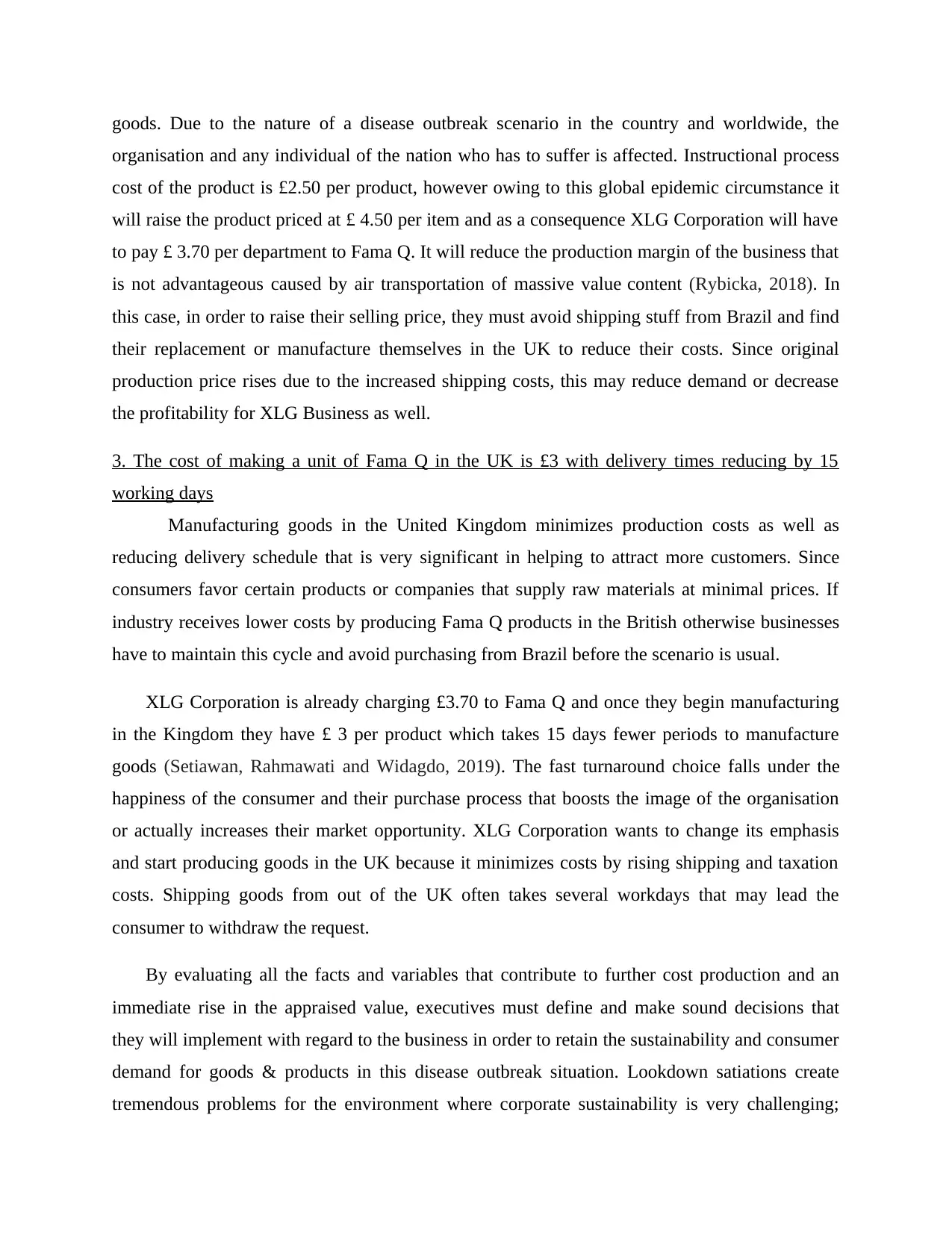
goods. Due to the nature of a disease outbreak scenario in the country and worldwide, the
organisation and any individual of the nation who has to suffer is affected. Instructional process
cost of the product is £2.50 per product, however owing to this global epidemic circumstance it
will raise the product priced at £ 4.50 per item and as a consequence XLG Corporation will have
to pay £ 3.70 per department to Fama Q. It will reduce the production margin of the business that
is not advantageous caused by air transportation of massive value content (Rybicka, 2018). In
this case, in order to raise their selling price, they must avoid shipping stuff from Brazil and find
their replacement or manufacture themselves in the UK to reduce their costs. Since original
production price rises due to the increased shipping costs, this may reduce demand or decrease
the profitability for XLG Business as well.
3. The cost of making a unit of Fama Q in the UK is £3 with delivery times reducing by 15
working days
Manufacturing goods in the United Kingdom minimizes production costs as well as
reducing delivery schedule that is very significant in helping to attract more customers. Since
consumers favor certain products or companies that supply raw materials at minimal prices. If
industry receives lower costs by producing Fama Q products in the British otherwise businesses
have to maintain this cycle and avoid purchasing from Brazil before the scenario is usual.
XLG Corporation is already charging £3.70 to Fama Q and once they begin manufacturing
in the Kingdom they have £ 3 per product which takes 15 days fewer periods to manufacture
goods (Setiawan, Rahmawati and Widagdo, 2019). The fast turnaround choice falls under the
happiness of the consumer and their purchase process that boosts the image of the organisation
or actually increases their market opportunity. XLG Corporation wants to change its emphasis
and start producing goods in the UK because it minimizes costs by rising shipping and taxation
costs. Shipping goods from out of the UK often takes several workdays that may lead the
consumer to withdraw the request.
By evaluating all the facts and variables that contribute to further cost production and an
immediate rise in the appraised value, executives must define and make sound decisions that
they will implement with regard to the business in order to retain the sustainability and consumer
demand for goods & products in this disease outbreak situation. Lookdown satiations create
tremendous problems for the environment where corporate sustainability is very challenging;
organisation and any individual of the nation who has to suffer is affected. Instructional process
cost of the product is £2.50 per product, however owing to this global epidemic circumstance it
will raise the product priced at £ 4.50 per item and as a consequence XLG Corporation will have
to pay £ 3.70 per department to Fama Q. It will reduce the production margin of the business that
is not advantageous caused by air transportation of massive value content (Rybicka, 2018). In
this case, in order to raise their selling price, they must avoid shipping stuff from Brazil and find
their replacement or manufacture themselves in the UK to reduce their costs. Since original
production price rises due to the increased shipping costs, this may reduce demand or decrease
the profitability for XLG Business as well.
3. The cost of making a unit of Fama Q in the UK is £3 with delivery times reducing by 15
working days
Manufacturing goods in the United Kingdom minimizes production costs as well as
reducing delivery schedule that is very significant in helping to attract more customers. Since
consumers favor certain products or companies that supply raw materials at minimal prices. If
industry receives lower costs by producing Fama Q products in the British otherwise businesses
have to maintain this cycle and avoid purchasing from Brazil before the scenario is usual.
XLG Corporation is already charging £3.70 to Fama Q and once they begin manufacturing
in the Kingdom they have £ 3 per product which takes 15 days fewer periods to manufacture
goods (Setiawan, Rahmawati and Widagdo, 2019). The fast turnaround choice falls under the
happiness of the consumer and their purchase process that boosts the image of the organisation
or actually increases their market opportunity. XLG Corporation wants to change its emphasis
and start producing goods in the UK because it minimizes costs by rising shipping and taxation
costs. Shipping goods from out of the UK often takes several workdays that may lead the
consumer to withdraw the request.
By evaluating all the facts and variables that contribute to further cost production and an
immediate rise in the appraised value, executives must define and make sound decisions that
they will implement with regard to the business in order to retain the sustainability and consumer
demand for goods & products in this disease outbreak situation. Lookdown satiations create
tremendous problems for the environment where corporate sustainability is very challenging;
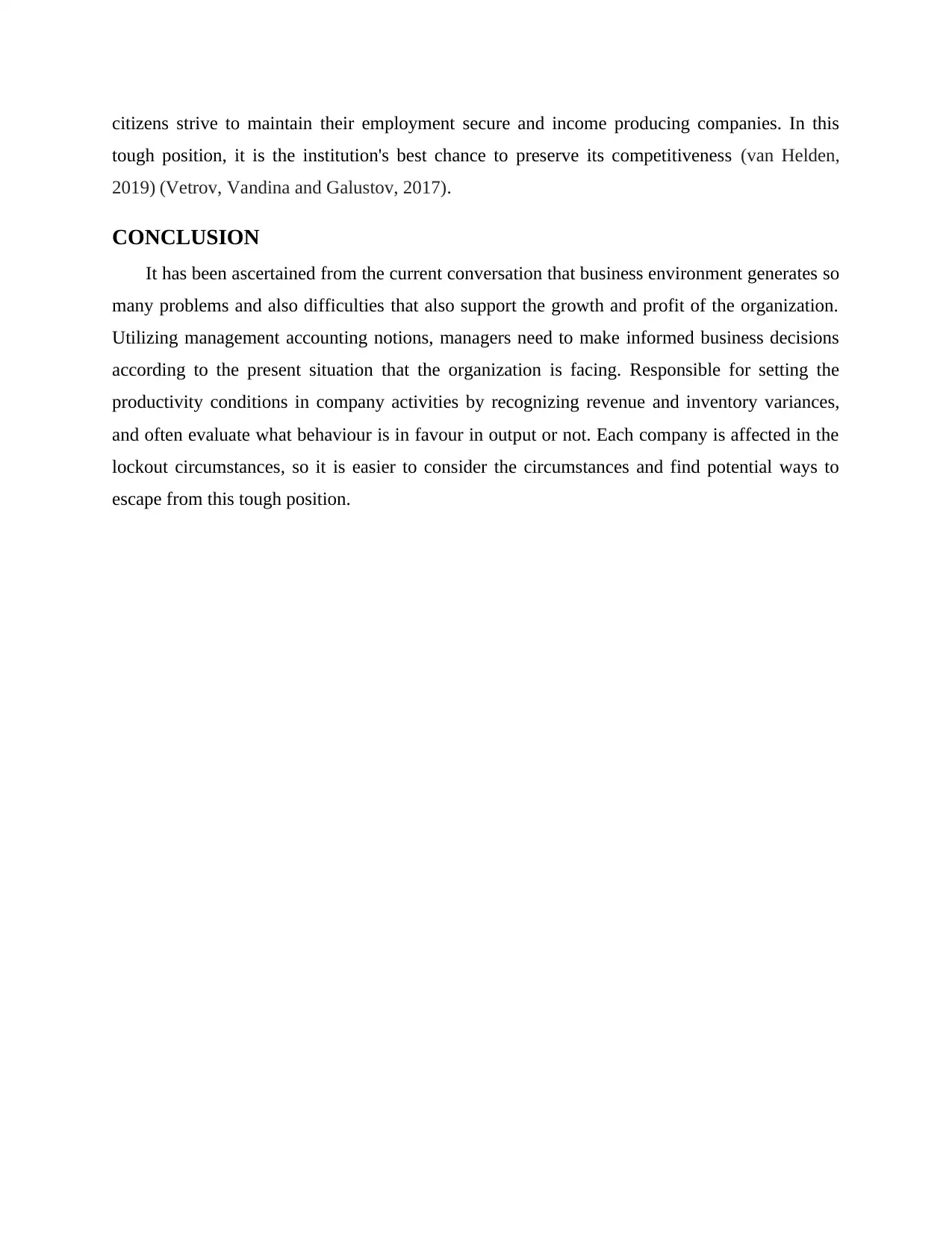
citizens strive to maintain their employment secure and income producing companies. In this
tough position, it is the institution's best chance to preserve its competitiveness (van Helden,
2019) (Vetrov, Vandina and Galustov, 2017).
CONCLUSION
It has been ascertained from the current conversation that business environment generates so
many problems and also difficulties that also support the growth and profit of the organization.
Utilizing management accounting notions, managers need to make informed business decisions
according to the present situation that the organization is facing. Responsible for setting the
productivity conditions in company activities by recognizing revenue and inventory variances,
and often evaluate what behaviour is in favour in output or not. Each company is affected in the
lockout circumstances, so it is easier to consider the circumstances and find potential ways to
escape from this tough position.
tough position, it is the institution's best chance to preserve its competitiveness (van Helden,
2019) (Vetrov, Vandina and Galustov, 2017).
CONCLUSION
It has been ascertained from the current conversation that business environment generates so
many problems and also difficulties that also support the growth and profit of the organization.
Utilizing management accounting notions, managers need to make informed business decisions
according to the present situation that the organization is facing. Responsible for setting the
productivity conditions in company activities by recognizing revenue and inventory variances,
and often evaluate what behaviour is in favour in output or not. Each company is affected in the
lockout circumstances, so it is easier to consider the circumstances and find potential ways to
escape from this tough position.
⊘ This is a preview!⊘
Do you want full access?
Subscribe today to unlock all pages.

Trusted by 1+ million students worldwide
1 out of 14
Related Documents
Your All-in-One AI-Powered Toolkit for Academic Success.
+13062052269
info@desklib.com
Available 24*7 on WhatsApp / Email
![[object Object]](/_next/static/media/star-bottom.7253800d.svg)
Unlock your academic potential
Copyright © 2020–2025 A2Z Services. All Rights Reserved. Developed and managed by ZUCOL.




